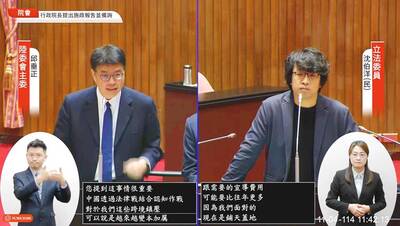Taiwan moved up six places in this year’s World Press Freedom Index, released yesterday by Reporters Sans Frontieres (RSF), but don't start cheering just yet.
The Paris-based watchdog organization said that the jump “does not reflect real improvements, but rather a global worsening of the situation in the rest of the world.”
According to the report, the number of countries with a “good” or “fairly good” state of the media has fallen by 2.3 percent, with press freedom deteriorating in nearly two-thirds of the 180 countries on the index.
At 45th place, Taiwan still boasts the most liberal press in Asia, with South Korea and Mongolia trailing in 63rd and 69th place respectively.
The ranking is one of the major factors that compelled RSF to open their first Asia bureau headquarters in Taipei earlier this month.
The organization chose Taipei over Hong Kong, which while 54th in 2012, has plummeted to a new low of 73rd, under the shadow of China — which consistently ranks within the bottom 10. Taiwan has remained relatively stable, hovering between 45th and 51st place since 2010. It now trails the US by two places.
The index describes Taiwan’s situation as “media freedom on hold,” stating that “the main threat to media freedom comes from China, which has been exerting growing economic and political pressure on the Taiwanese media.”
Local government officials are also directly interfering in the editorial policies of state-owned media, it said.
“Even in democracies like Japan, South Korea and Taiwan, media freedom shall never be taken for granted, as political and financial powers will always try to interfere if they get a chance,” RSF Asia Bureau director Cedric Alviani said. “Self-censorship is another problem … a lot of journalists cannot freely write what they want because they might get in trouble.”
Alviani said that China’s efforts to pressure businesses to censor media content can also affect Taiwan.
Recently, Apple TV blocked the satirical China Uncensored show not only in China, but also in Taiwan and Hong Kong. Produced in New York, the show is highly critical of Beijing and can still be viewed in Taiwan on YouTube.
“This is a big concern for us,” he said. “It is a very bad precedent that might lead to other things. It looks small, but it is not. There is a risk for Hong Kong, and Taiwan in a lesser measure, to be dragged down by Chinese intervention.”
Presidential Office spokesman Sidney Lin (林鶴明) said Taiwan’s improved rating in the index this year serves as proof that the nation’s years-long pursuit of progressive values of democracy, freedom and human rights has earned international recognition.
“Press freedom is a significant indicator when evaluating a nation’s level of freedom. Taiwan will continue to adhere to these values, consolidate democracy and dedicate itself to maintaining the stability and prosperity of the Asia-Pacific region,” Lin said.
Additional reporting by staff writer
This story has been corrected since it was first published.

CALL FOR SUPPORT: President William Lai called on lawmakers across party lines to ensure the livelihood of Taiwanese and that national security is protected President William Lai (賴清德) yesterday called for bipartisan support for Taiwan’s investment in self-defense capabilities at the christening and launch of two coast guard vessels at CSBC Corp, Taiwan’s (台灣國際造船) shipyard in Kaohsiung. The Taipei (台北) is the fourth and final ship of the Chiayi-class offshore patrol vessels, and the Siraya (西拉雅) is the Coast Guard Administration’s (CGA) first-ever ocean patrol vessel, the government said. The Taipei is the fourth and final ship of the Chiayi-class offshore patrol vessels with a displacement of about 4,000 tonnes, Lai said. This ship class was ordered as a result of former president Tsai Ing-wen’s (蔡英文) 2018

‘SECRETS’: While saying China would not attack during his presidency, Donald Trump declined to say how Washington would respond if Beijing were to take military action US President Donald Trump said that China would not take military action against Taiwan while he is president, as the Chinese leaders “know the consequences.” Trump made the statement during an interview on CBS’ 60 Minutes program that aired on Sunday, a few days after his meeting with Chinese President Xi Jinping (習近平) in South Korea. “He [Xi] has openly said, and his people have openly said at meetings, ‘we would never do anything while President Trump is president,’ because they know the consequences,” Trump said in the interview. However, he repeatedly declined to say exactly how Washington would respond in

WARFARE: All sectors of society should recognize, unite, and collectively resist and condemn Beijing’s cross-border suppression, MAC Minister Chiu Chui-cheng said The number of Taiwanese detained because of legal affairs by Chinese authorities has tripled this year, as Beijing intensified its intimidation and division of Taiwanese by combining lawfare and cognitive warfare, the Mainland Affairs Council (MAC) said yesterday. MAC Minister Chiu Chui-cheng (邱垂正) made the statement in response to questions by Democratic Progressive Party (DPP) Legislator Puma Shen (沈柏洋) about the government’s response to counter Chinese public opinion warfare, lawfare and psychological warfare. Shen said he is also being investigated by China for promoting “Taiwanese independence.” He was referring to a report published on Tuesday last week by China’s state-run Xinhua news agency,

‘ADDITIONAL CONDITION’: Taiwan will work with like-minded countries to protect its right to participate in next year’s meeting, the foreign ministry said The US will “continue to press China for security arrangements and protocols that safeguard all participants when attending APEC meetings in China,” a US Department of State spokesperson said yesterday, after Beijing suggested that members must adhere to its “one China principle” to participate. “The United States insists on the full and equal participation of all APEC member economies — including Taiwan — consistent with APEC’s guidelines, rules and established practice, as affirmed by China in its offer to host in 2026,” the unnamed spokesperson said in response to media queries about China putting a “one China” principle condition on Taiwan’s